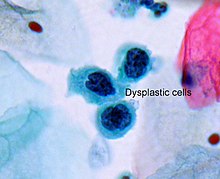Dysplasia


Dysplasia is any of various types of abnormal growth or development of cells (
hip dysplasia, myelodysplastic syndrome, and multicystic dysplastic kidney
.
In one of the modern
neoplasia, and dysplasias are thus generally not cancerous. An exception is that the myelodysplasias include a range of benign, precancerous
, and cancerous forms. Various other dysplasias tend to be precancerous. The word's meanings thus cover a spectrum of histopathological variations.
Microscopic scale
Epithelial dysplasia
| -plasia and -trophy |
|---|
|
|
Epithelial dysplasia consists of an expansion of immature cells (such as cells of the
neoplastic process. The term dysplasia is typically used when the cellular abnormality is restricted to the originating tissue, as in the case of an early, in-situ neoplasm.[citation needed
]
Dysplasia, in which cell maturation and differentiation are delayed, can be contrasted with metaplasia, in which cells of one mature, differentiated type are replaced by cells of another mature, differentiated type.[citation needed]
Myelodysplastic syndrome
Myelodysplastic syndromes (MDS) are a group of
blood.[2]
Fibrous dysplasia of bone
Fibrous dysplasia of bone is a disorder where normal
fibrous tissue, resulting in formation of bone that is weak and prone to expansion. As a result, most complications result from fracture, deformity, functional impairment and pain.[3]
Macroscopic scale
Hip dysplasia
Hip dysplasia is an abnormality of the
hip joint where the socket portion does not fully cover the ball portion, resulting in an increased risk for joint dislocation.[4] Hip dysplasia may occur at birth or develop in early life.[4] Regardless, it does not typically produce symptoms in babies less than a year old.[5] Occasionally one leg may be shorter than the other.[4] The left hip is more often affected than the right.[5] Complications without treatment can include arthritis, limping, and low back pain.[5]
Multicystic dysplastic kidney
Multicystic dysplastic kidney (MCDK) is a condition that results from the malformation of the
cystic disease, and it is a cause of an abdominal mass in infants.[6]
Etymology
From
]See also
References
- ^ "Definition of dysplasia". Merriam-Webster dictionary. Retrieved 2019-09-09.
- ^ a b c "Myelodysplastic Syndromes Treatment (PDQ®)–Patient Version". NCI. 12 August 2015. Archived from the original on 5 October 2016. Retrieved 27 October 2016.
- PMID 25719192.
- ^ a b c "Developmental Dislocation (Dysplasia) of the Hip (DDH)". American Academy of Orthopaedic Surgeons. October 2013.
- ^ PMID 27940740.
- ^ Multicystic Dysplastic Kidney Imaging at eMedicine
